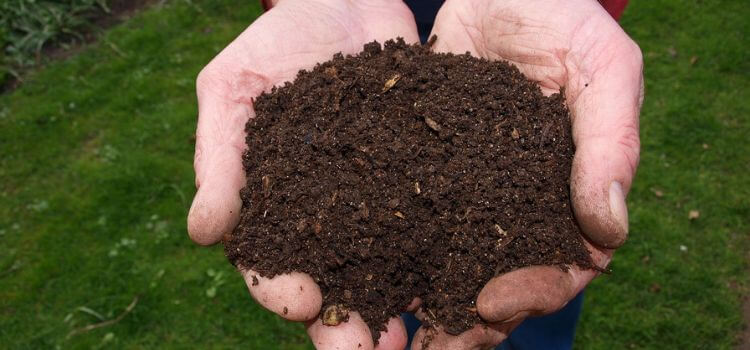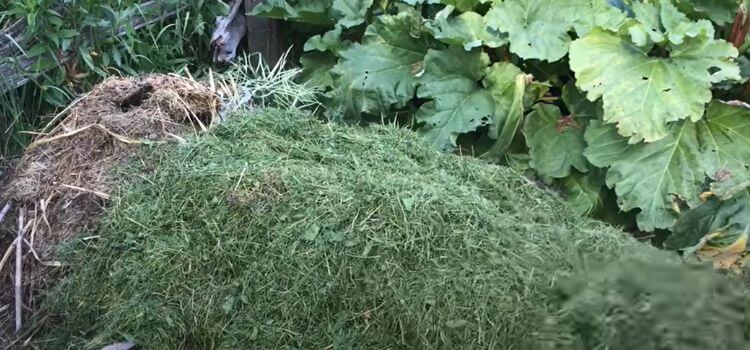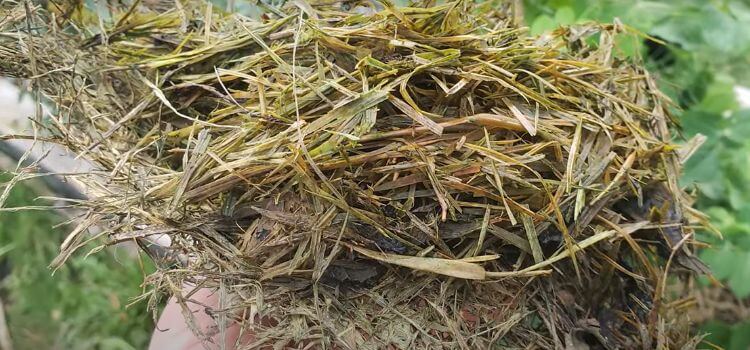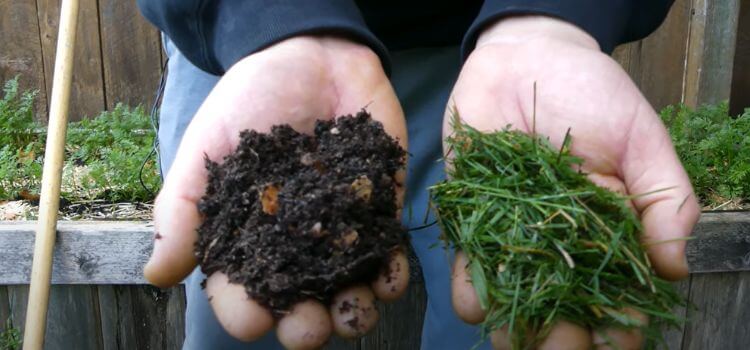As an Amazon Associate, I earn from qualifying purchases.
To compost grass clippings, mix them with dry materials and aerate the pile regularly. This helps balance nitrogen and carbon levels.
Grass clippings are an excellent source of nitrogen for compost. They decompose quickly and provide essential nutrients. Mix clippings with dry materials like leaves or straw to prevent matting and odour. Turn the pile frequently to introduce oxygen, which accelerates decomposition.
This method ensures a balanced compost with a proper mix of green and brown materials. Avoid adding too many grass clippings at once, as this can create a dense, anaerobic environment. Adequate composting for grass clippings reduces waste and enriches your garden soil with valuable organic matter.
Benefits Of Composting Grass Clippings
Composting grass clippings offers many rewards for your garden and the environment. It turns yard waste into valuable resources. Here are some key benefits of composting grass clippings.

Nutrient-rich Soil Amendment
Grass clippings are packed with essential nutrients. They provide nitrogen, potassium, and phosphorus. These are vital for plant growth.
When composted, these nutrients become more available to plants. This results in healthier, more vibrant gardens. The compost improves soil structure. It enhances water retention and reduces erosion.
Organic matter from composted grass clippings improves soil fertility. This leads to better root development and more vigorous plants.
Reduction Of Waste
Composting grass clippings reduces yard waste. It keeps landfills from overflowing. Grass clippings make up a significant portion of yard waste. By composting, you turn waste into a valuable resource.
This practice lowers your carbon footprint. It reduces the need for synthetic fertilizers, which often harm the environment.
Composting is a simple, effective way to manage yard waste. It benefits both your garden and the planet.
Summary Table Of Benefits
| Benefit | Description |
|---|---|
| Nutrient-Rich Soil | Provides essential nutrients like nitrogen, potassium, and phosphorus |
| Improved Soil Structure | Enhances water retention and reduces erosion |
| Waste Reduction | Reduces yard waste, keeping landfills from overflowing |
| Environmental Impact | It lowers carbon footprint and reduces the need for synthetic fertilizers |
Preparing Grass Clippings For Composting
Grass clippings are a great addition to compost piles. They are rich in nitrogen and decompose quickly. But proper preparation is critical to making the most of your grass clippings. Here are some steps to ensure your grass clippings are compost-ready.

Avoiding Pesticides And Herbicides
Pesticides and herbicides can harm the beneficial organisms in your compost pile. These chemicals can also end up in your garden soil. Always check if your grass has been treated with any chemicals.
- Use organic lawn care methods whenever possible.
- Wait at least two weeks after chemical treatment before collecting clippings.
If you are unsure, it’s best to avoid using treated grass clippings in your compost.
Shredding The Clippings
Shredding grass clippings helps them break down faster. Smaller pieces decompose more quickly and evenly.
- Use a lawnmower with a mulching blade to chop the grass.
- You can use a garden shredder if your lawnmower doesn’t have a mulching blade.
Spread the shredded clippings thinly in your compost pile. This helps air circulate and speeds up decomposition.
By following these steps, your grass clippings will be ready to turn into rich, fertile compost.
The Right Compost Bin
Composting grass clippings begins with selecting the proper compost bin. The correct bin ensures efficient composting and keeps your yard tidy. This section will guide you through the various types of compost bins and the key factors to consider regarding size and placement.
Types Of Compost Bins
There are several types of compost bins to choose from. Each type has its advantages:
- Plastic Bins: These bins are durable and retain heat well. They are ideal for small yards.
- Wooden Bins: Wooden bins are eco-friendly and can be built to any size. They blend well with garden aesthetics.
- Tumbling Bins: Tumbling bins make turning compost easy. They speed up the composting process.
- Wire Bins: Wire bins are inexpensive and provide excellent airflow. They are simple to set up.
Size And Placement Considerations
Choosing the right size and placement for your compost bin is crucial. Here’s what you need to know:
- Size: The size of your bin should match the amount of grass clippings you generate. A bin with a 3×3 foot dimension is usually sufficient.
- Placement: Place your bin in a shaded area to prevent it from drying out. Ensure it’s easily accessible for adding materials and turning the compost.
- Ventilation: Good airflow is essential for composting. Ensure your bin has adequate ventilation.
- Drainage: Proper drainage prevents waterlogging. Make sure your bin is elevated slightly off the ground.
You can efficiently compost grass clippings and enrich your garden soil by selecting the proper compost bin.
Layering Grass Clippings In The Compost Bin
Layering grass clippings in your compost bin can be a game-changer for your garden. Proper layering ensures that the compost decomposes efficiently, providing nutrient-rich soil. Follow these steps to make the most of your grass clippings.
Balancing Green And Brown Materials
Grass clippings are nitrogen-rich, making them a “green” material. Balance these with “brown” materials, which are rich in carbon. Common brown materials include:
- Dry leaves
- Straw
- Paper
A good rule of thumb is to use a ratio of 2 parts green to 1 part brown. This balance helps in faster decomposition and reduces odour.
Adding Water And Turning The Pile
Water is essential for the composting process. Keep the compost pile as moist as a wrung-out sponge. Too much water can cause the pile to become soggy, leading to foul smells. More water can speed up the decomposition process.
Turning the pile helps to aerate it, speeding up decomposition. Use a pitchfork or compost turner to mix the layers. Aim to turn the pile every 2-3 weeks for the best results.
| Step | Description |
|---|---|
| Add Grass Clippings | Spread a thin layer of grass clippings in the compost bin. |
| Add Brown Materials | Layer dry leaves or paper over the grass clippings. |
| Water the Pile | Moisten the pile until it’s damp but not soggy. |
| Turn the Pile | Mix the layers every 2-3 weeks to aerate. |
Following these steps can create a balanced and efficient compost pile. Your garden will thank you!
Monitoring The Composting Process
Monitoring your compost pile is crucial for success. Keeping an eye on the temperature, moisture, and aeration ensures your grass clippings break down efficiently. Let’s dive into the details.
Temperature And Moisture Levels
Temperature plays a crucial role in composting. Use a compost thermometer to check the pile’s core temperature. It should be between 135°F and 160°F. This range promotes microbial activity.

Moisture levels are equally important. Your compost should feel like a wrung-out sponge. Too much water can cause foul odours. Too little can slow down decomposition.
| Temperature | Action |
|---|---|
| Below 135°F | Turn the pile and add green materials |
| Above 160°F | Turn the pile and add brown materials |
Aeration And Decomposition Progress
Aeration is essential for composting. Turning the pile every 1-2 weeks introduces oxygen. This helps microbes break down the grass clippings.
Decomposition progress can be monitored by looking for changes in texture and color. Grass clippings will darken and become crumbly over time. This indicates proper decomposition.
- Turn the pile regularly for oxygen.
- Check for dark, crumbly texture.
- Add water if the pile is too dry.
Using Composted Grass Clippings In The Garden
Using composted grass clippings in the garden can be a game-changer. Composted clippings enrich the soil, adding essential nutrients. They boost the health of your plants and lawn.
Topdressing Lawns
Topdressing your lawn with composted grass clippings is easy and effective. It helps the grass grow more robust and greener.
Spread a thin layer of composted clippings over your lawn. Aim for about a quarter-inch thick layer. This allows the nutrients to penetrate the soil without smothering the grass.
Use a rake to distribute the compost evenly. This ensures that every part of your lawn benefits. The compost will slowly break down, feeding the grass over time.
Incorporating Into Soil For Planting
Composted grass clippings can also be mixed into the soil for planting. They improve soil structure and fertility.
Before planting, mix the compost into the top 6-8 inches of soil. This creates a nutrient-rich environment for your plants.
Here’s a simple table to help you understand the benefits:
| Benefit | Description |
|---|---|
| Improved Soil Structure | Compost helps soil retain moisture and aerate better. |
| Increased Nutrients | Plants get essential nutrients like nitrogen, phosphorus, and potassium. |
| Enhanced Growth | Stronger and healthier plant growth. |
Tips for using composted grass clippings in soil:
- Mix thoroughly to ensure even distribution.
- Avoid overloading the soil with compost to prevent nitrogen burn.
- Test your soil periodically to monitor nutrient levels.
By using composted grass clippings, you can transform your garden. Your plants and lawn will thrive with the added nutrients and improved soil structure.
A well-aerated pile will decompose faster and smell fresher. Keep these tips in mind for successful composting.
Pests can be attracted to your compost pile if it needs to be appropriately managed. Common pests include rodents, flies, and ants. To prevent infestations, consider these tips:
- Avoid composting meat or dairy products, as they attract pests.
- Cover the compost with a layer of soil or leaves.
- Use a compost bin with a tight-fitting lid to keep pests out.
Maintaining a clean and balanced compost pile deters pests and keeps your garden healthy.

Frequently Asked Questions
Yes, you can compost just grass clippings. Mix them with dry materials like leaves or straw to prevent odour and matting.
Grass cuttings typically take 3 to 6 months to compost. Turn the pile regularly for faster results. Keep the compost moist but not too wet.
To decompose grass clippings quickly, keep them moist and turn them regularly. I am adding nitrogen-rich materials like kitchen scraps or manure to speed up decomposition. Shredding the clippings into smaller pieces also helps.
Recycle grass clippings as mulch or compost. Leave them on the lawn for natural fertilization. Bag them for waste collection if needed.
Conclusion
Composting grass clippings is simple and beneficial for your garden. By following these steps, you enhance soil health. Start composting today to reduce waste and enrich your garden naturally. Remember, patience and consistency are key.
Happy composting, and enjoy a greener, healthier garden environment!

